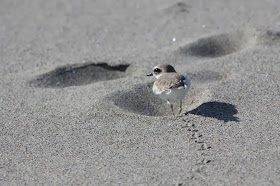and the next thing I know, I'm hiking among giant redwoods, exploring intriguing beaches, discovering new bird species and enjoying spectacular views of the California coast. Come with me to Stinson Beach!
On my first morning on the beach, I was presented with a life bird--the Snowy Plover--a captivating little shorebird that forages on terrestrial and aquatic invertebrates on barren beaches along the coast and inland waterways.
Even when I knew these plovers were in the vicinity, it was very hard to spot them unless they were moving. Though they are easy to find in the above image, walking on the beach is a different matter. Their plumage coloration and broken patterns lends itself to blending right into the sand and shadows as you walk along the beach.
The juvenile, above and below, left tiny footprints in the moist sand as he headed for a depression caused by an earlier human footprint. Once he settled in, he became still and "invisible" once again.
The bird below, appears to be a female because of her light color, but it is winter (Feb 17th), even in California, and winter plumage in the plover sexes can sometimes be indistinguishable.
Notice the leg bands worn by the birds in many of the images. With the exception of the juvenile above, this group of plovers wore multiple colored bands, some wearing red, green, yellow or blue bands arranged in different combinations on both legs. The placement and color of the bands helps researchers distinguish individuals and aids in monitoring nesting populations and nesting success. (The bird above has bands of green over red, while the bird below wears red above.)
Snowy Plovers are either endangered or threatened in areas where they occur largely because of degradation of habitat and encroachment by expanding development. Humans and dogs frequently disturb nesting and foraging birds on beaches that are heavily used for recreation.
In fact, the online edition of the Birds of North American on the Snowy Plover published in 2009, describes studies showing that Snowy Plovers are 16 times more likely to be disturbed on a public beach than a protected beach.
In one study, on average, each plover was disturbed every 27 minutes on weekends and every 45 minutes on week days. Feeding rates decreased with human activity and disturbance was noted when humans were within 43 yards of the bird. The birds are disturbed by the presence of dogs at an even greater distance.
In the next several images, plovers in the small group stretch their wings and legs...
preen...
and probe the sand at the base of a low growing plant in search of invertebrates.
These behaviors give the impression that disturbance is minimal, which is what I hope for. I am using a 400 mm lens while lying stationery on the beach and the images I have posted here are cropped, making the subjects appear closer than they were in the moment. As you look at some of the images, however, you will notice that in several of them, the bird is looking at the camera. When a wildlife subject is looking at you, you have disturbed it.
I thanked them for our short visit, wished them many seasons of successful nesting, and said goodbye to some of the sweetest little shorebirds ever! Next: The rest of my first day at Stinson Beach--the Dipsea Trail.
Links and resources:
Cornell on the Snowy Plover
Stinson Beach, CA
Birds of North America

















You have new subjects for sketches. I see that some of the plovers have been tagged. It will be interesting to see what if anything you could find out about them.
ReplyDeleteHi Lisa,
DeleteColor bands usually mean that a local conservation group is monitoring the birds for their survival, migration and nesting success. In many cases, volunteers are posted on beaches where snowy plovers are nesting during the breeding season to help minimize disturbance. That becomes a real challenge on a public beach.